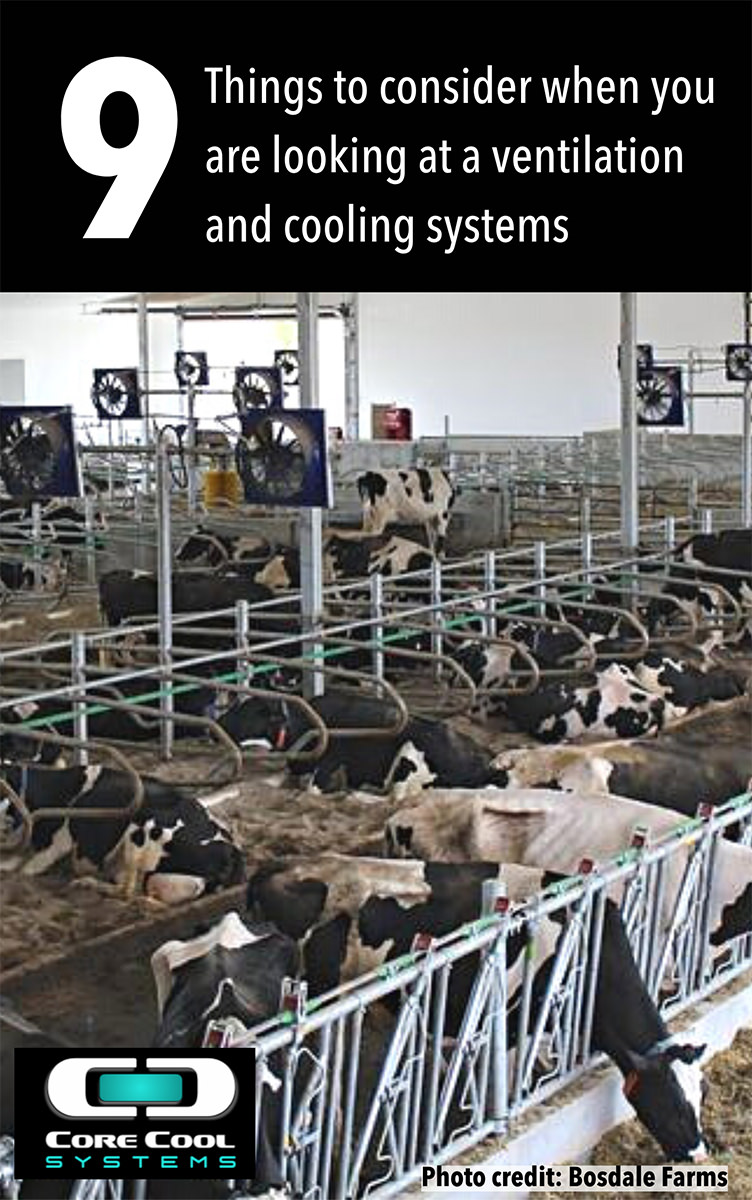Title search: ✖
|
Show All (59)
Cooling Cows (37) Cow Comfort (6) Dry Cow Cooling (1) Fall Lameness (2) FAQ's Answered (7) Metabolic Issues (2) Reproduction (2) Why Focus on Core Body Temperature (5)
If Nights Don’t Cool, Days Fall Apart Why Nighttime Recovery is the Missing Piece in Heat Stress Management
Natural Ventilation Dairy Barns: Why They Can’t Prevent Heat Stress in Modern Dairy Cows — Even in “Cool” Climates
How Mild Heat Stress Eats Into Profits Every Day You Won’t See It Coming—But You’ll Feel It in Your Bottom Line
FAQ - Why should I cool my dry cows? What impact does heat stress have on the cow, her next lactation, the calf in utero
Why is it important to keep cows' core body temperature cool, and how does Core Cool Systems achieve this?
Maximizing Dairy Herd Reproductive Health: Understanding the Impact of Heat Stress and Investing in Cooling Solution.
Are your summer electricity bills causing you to shudder? Maybe your barn fans are one of the biggest culprits.
Why is it important to clean your fans before summer? Are dirty fans costing you time, money and energy?
|
The Critical Role of Dry Cow Cooling: Enhancing Future Herd PerformanceKeeping lactating cows cool is an investment that pays dividends in milk production alone, but did you know there are incredible benefits to be had from cooling your dry cows too? The dry period is a crucial time in a dairy cow's life, but this group often receives less attention than it deserves. Proper cooling during the dry period is not just about comfort—it is critical in shaping the future performance and health of both the dam and her offspring. Why Dry Cow Cooling Matters Dry cows are not just waiting for their next lactation; they are preparing for it. The dry period is vital for maintaining udder health, improving milk production and quality, and ensuring the overall well-being of dairy cattle. By providing a structured and well-managed dry period, farmers can enhance the productivity and longevity of their herd and a more successful next lactation for the cow. This period allows cows to regain body condition and recover from metabolic stresses, setting the stage for a smoother transition into the next lactation. Effective dry period management also reduces the risk of disease and metabolic disorders after calving, promoting better overall health and reducing veterinary costs. Heat stress during this period can have significant long-term effects on cow health and productivity. Here’s why effective cooling is essential: 1. Impact on Immune Function: Heat stress during the dry period negatively affects the cow's immune system. Studies have shown that cooling dry cows improves two key immune functions: neutrophil phagocytosis and oxidative burst activity.
Heat-stressed cows show increased levels of interleukin-10, a protein that can suppress the immune response. This suppression can result in higher disease rates, such as mastitis and respiratory issues, in the cows' next lactation period (Thompson et al., 2017; Thompson & Dahl, 2020). 2. Enhanced Milk Production: Cooling dry cows can lead to improved milk yield in the next lactation. Research indicates that cows cooled throughout the dry period produce more milk — by 4 to 5 kg per day — compared to those that experience heat stress during this crucial phase (Fabris et al., 2022). This increase in milk yield not only enhances productivity but also contributes to the overall profitability of the dairy operation. 3. Reduction in Health Issues: Cows cooled during the dry period have a reduced risk of health problems such as displaced abomasum and mastitis. This is attributed to their improved immune function and better overall condition, translating into fewer health complications after calving (Beede & Collier, 2022). 4. Improved Calf Health: The benefits of cooling extend to the calves as well. Heat stress in dry cows can affect the quality of colostrum and the health of the newborn calf. Providing proper cooling helps ensure that calves receive high-quality colostrum, which is vital for their immune development and overall health (LaPorta et al., 2023). When the dam experiences heat stress during pregnancy, it can have significant impacts on the calves' future. Here are just 5 of the ways a calf's future can be impacted before it’s even born by heat stress:
For farmers, the consequences of heat stress translate into significant financial and performance challenges. Proactively managing heat stress by implementing effective strategies, such as upgrading cooling systems and ensuring proper hydration, can safeguard the health of future calves and improve overall herd productivity. Addressing heat stress is not just about immediate comfort; it's a strategic investment that boosts the efficiency and profitability of the dairy operation. By prioritizing reducing, minimizing, or preventing heat stress, farmers can ensure a healthier, more productive herd; that is all part of secure long-term financial stability. Effective Cooling Strategies Implementing effective cooling strategies for dry cows involves several key components:
Economic Considerations Investing in cooling systems is not just a health-related decision but also an economic one. Studies have shown that heat stress in dry cows results in substantial financial losses across the dairy industry. In the U.S., the economic impact is estimated at around $1.5 billion annually. Therefore, implementing effective cooling strategies, such as fans and evaporative cooling, not only improves herd health and productivity but also makes sound financial sense (Dahl, 2022). Testimonial: A Dairy Farmer’s Experience Cooling Dry Cows Since 2016 A dairy farmer near Ottawa, ON, using Core Cool Systems, shares his experience: “We installed the system in 2016. Since then, temperature stress has been taken out of the equation. The cows' core body temperature is maintained, and they never go into heat stress. Conclusion Cooling dry cows is a vital component of a successful dairy operation. Investing in effective cooling strategies can enhance your herd's health, productivity, and overall performance. The benefits are clear: improved milk yield, better calf health, and reduced health issues are all achievable with the right approach to dry cow cooling. Consider incorporating advanced cooling systems like Core Cool Systems to support your herd's long-term success. Elevate Your Herd's Future Don't let heat stress compromise the health and productivity of your dry cows and their unborn calves. With Core Cool Systems, you can ensure optimal comfort and cooling, setting the stage for healthier, more productive herds. Invest in the best for your cows. Choose Core Cool Systems to protect your livestock and maximize your farm’s profitability. Contact us today at nancy@corecoolsystems.com or WhatsApp +1-330-717-8852 to learn how our innovative solutions can make a difference!
Share: https://www.corecoolsystems.com/blog/Blog48/The-Critical-Role-of-Dry-Cow-Cooling-Enhancing-Future-Herd-Performance Share Category "Cooling Cows": Share Category "Dry Cow Cooling": |

